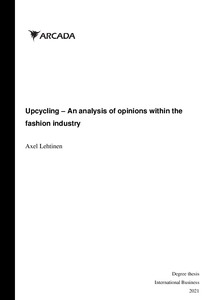Upcycling: An analysis of opinions within the fashion industry
Lehtinen, Axel (2021)
Lataukset:
Lehtinen, Axel
2021
Julkaisun pysyvä osoite on
https://urn.fi/URN:NBN:fi:amk-2021060213354
https://urn.fi/URN:NBN:fi:amk-2021060213354
Tiivistelmä
Upcycling refers to the practice of creating a product made from of products, components or materials which have reached the end of their lifespan, whose quality and/or value is higher than the original element. The process allows for increased longevity of the product, thus reducing the overall need for newly produced raw materials and products, as well as a reduction in overall resource and energy consumption. By utilizing upcycling on a larger scale, industries could greatly limit environmental harm through the reduction of emissions from production and shipping of new products and materials. Given these theoretical benefits, upcycling has received more recognition as a sustainable alternative to traditional production in recent years.
The purpose of this thesis was to gain an insight into the thoughts and opinions held within the fashion industry in regard to the topic of upcycling. The primary data used to achieve this goal was collected by conducting semi-structured interviews with professionals at companies with differing levels of upcycling adoption. A qualitative approach was chosen so as to gain a deeper understanding of each participants’ thought on the matter. In this thesis, the different ways upcycling is utilized by companies will be discussed, as well as other initiatives taken by companies to mitigate environmental pollution. The results show that while production waste-based upcycling is a viable option for reducing general waste, large-scale end-of-life based upcycling is not yet viable.
The purpose of this thesis was to gain an insight into the thoughts and opinions held within the fashion industry in regard to the topic of upcycling. The primary data used to achieve this goal was collected by conducting semi-structured interviews with professionals at companies with differing levels of upcycling adoption. A qualitative approach was chosen so as to gain a deeper understanding of each participants’ thought on the matter. In this thesis, the different ways upcycling is utilized by companies will be discussed, as well as other initiatives taken by companies to mitigate environmental pollution. The results show that while production waste-based upcycling is a viable option for reducing general waste, large-scale end-of-life based upcycling is not yet viable.
